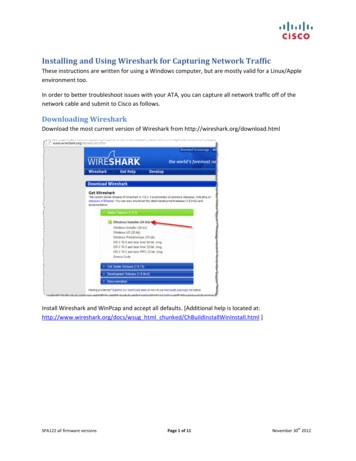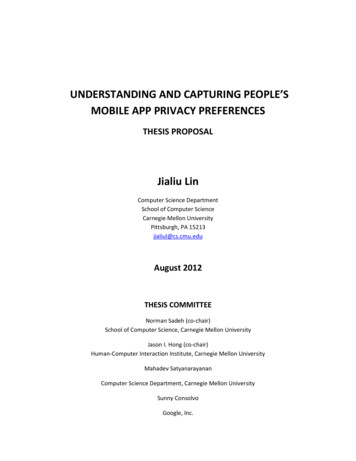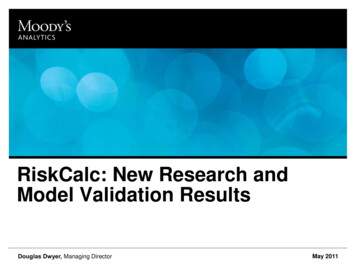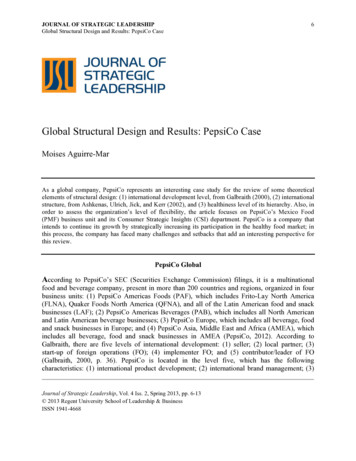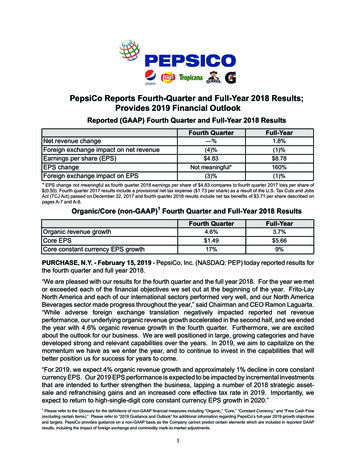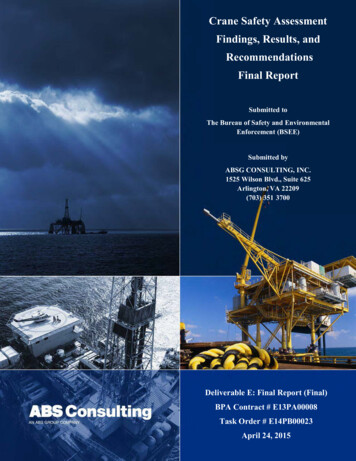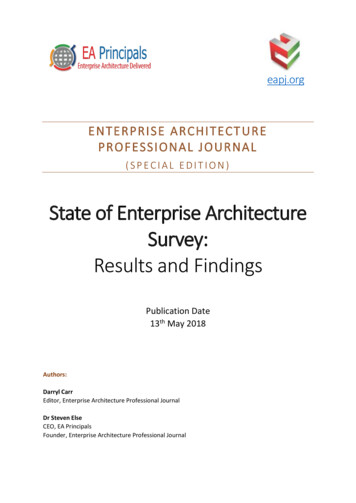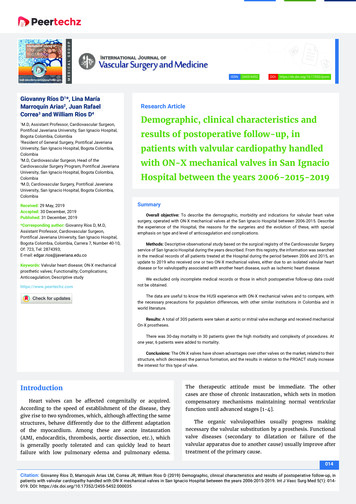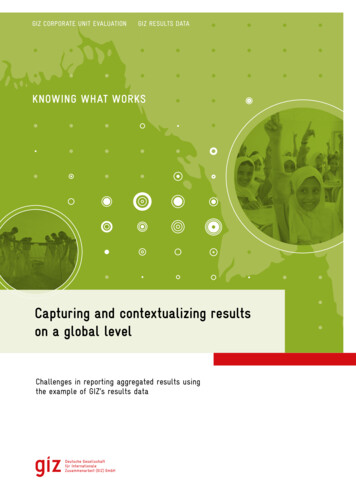
Transcription
GIZ CORPORATE UNIT EVALUATIONGIZ RESULTS DATAKNOWING WHAT WORKSCapturing and contextualizing resultson a global levelChallenges in reporting aggregated results usingthe example of GIZ’s results data
IMPRINTAs a federally owned enterprise, GIZ supports the German Government in achieving its objectives in the field ofinternational cooperation for sustainable development.PUBLISHED BYDeutsche Gesellschaft für InternationaleZusammenarbeit (GIZ) GmbHREGISTERED OFFICESBonn and EschbornFriedrich-Ebert-Allee 36 4053113 BonnT 49 228 44 60-0F 49 228 44 60-1766Dag-Hammarskjöld-Weg 1–565760 EschbornT 49 61 96 79-0F 49 61 96 79-1115E evaluierung@giz.deI www.giz.de/evaluationRESPONSIBLEDr. Ricardo Gomez, Director, GIZ Corporate Unit EvaluationCONCEPTION, COORDINATION UND MANAGEMENTClaudia Kornahrens, Head of Section Central Project Evaluation,GIZ Corporate Unit EvaluationDr. Susanne Milcher, GIZ Corporate Unit EvaluationAUTHORSOliver KarkoschkaDr. Susanne Milcher, GIZ Corporate Unit EvaluationDr. Judith Müller-Gerold, GIZ Corporate Unit EvaluationLennart Bendtfeld-Huthmann, GIZ Corporate Unit EvaluationREVISIONpfiff – Pressefrauen in FrankfurtCarmen SorglerDESIGNDITHO Design GmbH, KölnLAYOUTSCHUMACHER — Brand Interaction Design, DarmstadtPRINTING AND DISTRIBUTIONBonn, October 2017
Contents1. Capturing results on a global levelWhat are results data and why are they collected? . . . . . . . . . . . . . . . . . . . . . . . . . .42. The 2016 data collection surveyHow has GIZ collected its 2016 results data? . . . . . . . . . . . . . . . . . . . . . . . . . . . . .93. From the indicator to the statement of resultsFindings of the 2016 data survey . . . . . . . . . . . . . . . . . . . . . . . . . . . . . . . . . . 124. Supplementary qualitative analysisSelected examples behind the numbers . . . . . . . . . . . . . . . . . . . . . . . . . . . . . . . 235. Outlook for 2018Refining the aggregated collection of results . . . . . . . . . . . . . . . . . . . . . . . . . . . . . 32
1Capturing results at global levelWhat are ‘results data’ and why are they collected?What is GIZ’s specific contribution to solving regional and global problems? What doesit do, say, to mitigate the impacts of climate change or reduce global poverty? Forexample, in the period 2010–2015 how many people worldwide found employment asa result of GIZ projects? And how many of them were women? It is not only expertswho are interested in the answers to these questions—the general public also wantsmore information about the results achieved. Reporting in international cooperationin connection with the 2030 Agenda and the Sustainable Development Goals (SDGs)focuses not just on finances and activities but increasingly on results and targetsachieved. Like other organisations involved in international cooperation, GIZ is there fore faced with the task of providing the best possible proof of the effectivenessof its work and communicating this in a readily understandable way, not just for in dividual projects, but also on a global level. GIZ collects results data across allprojects and countries every two years. This brochure summarises the outcomes ofthe latest data survey in 2016 and describes both the potential and the limitationsof the aggregated reporting of results.Results orientation is one of the key quality features of GIZ’s work. Monitoring andevaluation therefore focus strongly on substantiating results and boosting impact. Yetthings that are easy to do for individual projects are difficult at aggregated level—thatis, across projects and national boundaries, on a regional or global level. How can wecombine individual results from projects that are implemented under different overallconditions and in different contexts? After all, when formulating project objectivesand indicators, care is rightly taken to make sure they reflect the specific nationalsetting and are tailored to the respective partners. This is essential if they are to provide
Capturing and contextualizingresults on a global level05a suit able basis for project steering and for learning within the project, as well as forpromoting ownership by partners. Objectives and indicators are often therefore veryspecific and heterogeneous, even for projects in the same sector.Objective and purpose: Communication with the general publicIn recent years GIZ has carefully explored how results can still be collated across projectsand countries despite these difficulties. Since 2014 it has regularly collected globalresults data using ‘aggregate indicators’ and it has made the aggregated collection andreporting of results a part of its corporate strategy. The strategy envisages that boththe collection and the communication of results will be developed further so that thegeneral public, commissioning parties, partners and also staff have access to user-friendlyand client-oriented aggregated data. GIZ has decided to use the aggregated data mainlyfor communication with the general public and dialogue with commissioning parties.This decision influences the content of the aggregate indicators and the methodologicalrequirements. Because international cooperation is always under pressure to demonstrateits legitimacy, data that provide evidence of results beyond project boundaries can beused in the public debate on effectiveness to help illustrate the outcomes of internationalcooperation and secure the backing of society.What are aggregate indicators?GIZ defines aggregate indicators as clearly formulated indicators onwhich data can be collected from different projects and programmes—operating in different contexts and under different conditions—usingthe same methods (including the unit of measurement), and coveringthe same period. The indicators must generate quantifiable data andbe easy to measure. Aggregate indicator data do not necessarily haveto be collected by all projects in a sector, only by those whose pro ject approach is consistent with the focus of one or more aggregateindicators. Examples of aggregate indicators are shown in the overview of the 2016 results data on page 13
06Capturing and contextualizingresults on a global levelWhat are the particular features of GIZ’s aggregate indicators?Primarily quantitativeThe majority of GIZ’s aggregate indicators are quantitative, because quantitative factorsare easier to combine. Qualitative results can also be aggregated, but these too arefrequently combined in terms of quantity, e.g. by looking at the number of individualswhose working conditions have improved. There are many qualitative aspects thatare hard to present even at project level. In these cases, aggregation is not feasible andindividual examples must be cited instead.Data collection at all results levelsAggregate indicators can be compiled and measured at all results levels. It is generallyeasier to demonstrate what outputs (output level) have been provided than to measurewhat results (outcome level) these generated and what overarching development results(impact level) were thereby achieved. But the most appropriate results level dependsmain ly on the individual sector and project approaches. It is particularly difficultto at tribute the identified results to a specific project intervention. For this reason, GIZalso works with plausible estimates (‘educated guesses’) when collecting data on resultsat outcome and impact level.Limitations of GIZ’s results dataThey . . only provide absolute figures, not comparative values(e.g. on how local conditions are changing). . do not measure sustainability (e.g. they provide no information on whether people stay in newly created jobs). . only cover projects that have provided feedback.Projects that have not provided any data are ignored. are an excerpt of the portfolio, because the indicators depict selected topics and project types.
Capturing and contextualizingresults on a global level07Complementary to project indicators and evaluations resultsOn a cross-project level, aggregate indicators aim for easily quantifiable aspects. Theaggregated level requires for the “educated guess” or “well-informed guess” which isa plausible estimation based on empirical values, monitoring data, and evaluation results.In contrast, project indicators are an integral and mandatory component of projectmanagement and function as steering tools. Within project evaluations, projectindicators assess the project’s effectiveness and allow for a retrospective critical analysis.Results only measured at a specific point in timeAggregate indicators do not enable us to draw any conclusions about development overthe course of time. To do so, the projects would have to collect data on the indicatorsat exactly the same time in specific measurement periods. This is rarely possible, becauseprojects have different terms and progress in different ways (e.g. portfolio shift to adifferent sector). They also end at different times. Furthermore, in some cases—such aspolicy consulting—what the results are and whether the objectives have been achievedmay not become clear until very much later. However, because the measurement periodis clearly defined, it is clear what period the data relate to.Not obligatoryIn contrast to the practice of other organisations, aggregate indicators are not a man da tory part of GIZ project results frameworks: if they were mandatory there would be arisk that objectives and resources might be modified in order to push up the values of theaggregate indicators (standardisation of objectives and indicators). There would also be arisk of creating a system that incentivises ‘low hanging fruit’. Such a shift towards easilyachievable and short-term objectives could diminish the quality and sustainability ofmeasures and approaches and divert attention away from the qualitative changes that arethe main aim of project work.Without targetsGIZ has also made a deliberate decision not to collect baseline data or define targetvalues for the indicators. Defining target values in advance poses difficulties in termsof methodology because unforeseeable crises or portfolio shifts may mean that thesame projects may not be able to provide data over the course of time and that a targetvalue can either no longer be achieved or is no longer comparable with a baseline. Thereis also a very real risk that target values may conflict with partner countries’ needs ordevelopment priorities.
08Capturing and contextualizingresults on a global levelThe limitations of aggregate indicatorsAggregate indicators must be very broadly worded and not refer to any specific contextso that the largest possible number of projects can report on them. In many cases, thatmakes them unsuitable for steering portfolios and projects. Furthermore, they cannotbe used to make comparisons with other interventions in the sector, because contextdependent factors cannot be taken into account. Consideration of such factors is essentialfor plausible comparisons. Finally, aggregate indicators can only map easily quantifiablepartial aspects of projects, not their full results. They therefore do not do justice to thediversity of approaches, topics and instruments involved.01 / See Holzapfel 2014.Presenting Results inDevelopment Cooperation:Risks and Limitations,DIE. Bonn; OECD 2017.Strengthening the resultschain: Synthesis of casestudies of results-basedmanagement by providers:Discussion Paper.02 / USAID2016. Feed the FutureIndicator Handbook:Definition Sheets.Washington DC; ADB 2017.Results FrameworkIndicator Definitions.Manila; EC 2016. EUInternational Cooperationand Development—FirstReport on Selected Results,July 2013–June 2014.Brussels.03 / USAID 2016. GCCStandard IndicatorHandbook: Definition Sheets.Washington DC; USAID 2016.Feed the Future IndicatorHandbook: Definition Sheets.Washington DC.04 / ADB 2017. ResultsFramework IndicatorDefinitions. Manila;EU 2016. First Reporton Selected Results,July 2013–June 2014.Brussels.05 /DFID 2016. CorporateReport: DFID ResultsFramework results 2011to 2015 by sector.London; DFAT 2015.Performance of AustralianAid 2015–16. Barton.What do other organisations measure and how?Faced by growing demands for information from the general public, more and moreorganisations involved in international cooperation are finding that they need to givean account of the global results of their work. In 2008 the Asian Development Bank(ADB) became the first multilateral organisation to collect data for the purpose ofpresenting results in aggregated form. Other organisations, including the EU and thedevelopment agencies of the UK and the USA, followed suit. Although the variousorganisations have adopted different approaches to the aggregated reporting of results,they have come up against the same limitations and risks.1 The selected topics usuallycover a wide range of sectors and reflect the areas of activity—such as health, education,water, rural development, climate and energy—that are strategically and politicallyrelevant to the organisation. Like GIZ, the organisations usually view the measuredresults as a contribution made jointly with other partners. They do not attribute theseresults directly or exclusively to their intervention.2More and more organisations, including the United States Agency for InternationalDevelopment (USAID) and the UK Department for International Development (DFID),use mandatory standard indicators relating to strategically relevant issues that meas u redirect results (output level) or short-term indirect results (outcome level) in the moni toring system of ongoing projects or programmes.3 This makes it possible to under t akesystematic and regular collection of data on the contributions to results that have beenachieved in partner countries. By contrast, both the ADB and the EU consider onlycompleted projects and collect data on the aggregated results by means of quantitativeindicators at output and outcome level. In these cases the data for the reporting ofresults are usually based on the final reports of projects or programmes and the orga nisations’ annual reports.4Unlike GIZ, some organisations formulate target values in advance so that they canbetter assess the progress of their contributions. The extent to which objectives havebeen achieved is either measured in aggregated form on the basis of individual objectivesdefined at project or programme level or else compared with a target value that appliesto all interventions and is defined at organisation level (e.g. DFAT vs. DFID).5
Capturing and contextualizingresults on a global level209The 2016 data surveyHow has GIZ collected its 2016 results data?For the 2016 results data the Management Board selected 22 topics, such asquestions about basic provision for refugees and about the number of people whohave found employment as a result of GIZ measures. For an issue to be selected, theinformation obtained had to be strategically relevant to GIZ’s PR work, and GIZ’sworldwide portfolio on the issue had to be large enough to yield sufficient data. Inaddition, the issues needed to be related to the Sustainable Development Goals (SDGs)and the current special initiatives (‘One World – No Hunger’, ‘Tackling the root causesof displacement, reintegrating refugees’ and ‘Stabilisation and development in NorthAfrica and the Middle East’) of the German Federal Ministry for Economic Cooperationand Development (BMZ).Collecting data and verifying plausibilityResults data relating to these issues was collected from some 800 projects in elevensectors using 34 aggregate indicators. The data covered the period 2010–2015 andwas collected with the assistance of the social research organisation UmfragezentrumBonn. The aggregate indicators were formulated by staff experts responsible for therelevant areas in collaboration with the Corporate Evaluation and Communicationsunits. Before data was collected, the sectoral experts were involved in drawing upprecise instructions for each aggregate indicator that specified what measures were to beincluded in the measurement process or educated guesses and what was to be excluded.During the June/July 2016 survey period project managers were asked to inputtheir data on these indicators, based on measurements or edu c ated guesses, into a surveyportal. An example of an educated guess would be using the number of water supplyand sewage disposal companies supported and the popu lation of the c atch ment area asa basis for estimating the number of people who have been reached by the measureand have therefore benefitted from it. The plausibility of the results was then veri fied bythe Evaluation Unit and the Sectoral Department, who had the collected data checked
10Capturing and contextualizingresults on a global levelCriteria for formulating theaggregate indicators for the2016 results dataThe aggregate indicators must be easy to communicate and formulated in a clear and easilyunderstood way in order to convey an effective PR message; be framed in substantive terms such that the largest possiblenumber of projects in a sector can provide data; depict aspects of a sector that be easily measured and quantified or plausibly estimated and must involve datathat is not time-consuming to collect; be precisely worded so that they can be understood easilyand in the same way in all contexts and under all conditions; relate in some way to the Sustainable DevelopmentGoals (SDGs); call for absolute figures, because percentages cannotbe aggregated without simultaneously recording the entirestatistical population; if possible, be able to provide information differentiatedby gender.
Capturing and contextualizingresults on a global level11by the relevant experts at country and project level, and corrected if necessary orconfirmed. An important aspect of this was the personalised enquiry, which was initiatedfor the first time and meant that there were opportunities for feedback to the relevantproject managers.Because of the scope for interpretation that always arises with educated guesses,there was uncertainty about whether feedback of results should occur and if so to whatextent. This is principally because of: the diversity of project types and their contributions to results, the ‘long results chain’ from the measure to the result at target group level inprojects involving the provision of advice to governments, the different ways of crediting/assessing GIZ’s contribution in projects sponsoredby different donors (co-financing).Even within projects of the same type, these uncertainties resulted in differencesin the data collected (‘positive’ versus ‘cautious’ estimates) which necessitated timeconsuming post-processing by the Sectoral Department during the plausibility check.GIZ is currently working on standardising the procedure for educated guesses forall indicators in order to reduce the scope for interpretation.Collecting climate data – a challengeIt is difficult to put precise figures on the extent to which people benefit indirectlyfrom measures that promote adaptation to climate change. GIZ’s consultancyservices are often designed to boost the capacity of institutions and encouragethe mainstreaming of adaptation measures in development plans, but it does notnecessarily follow from this that the entire population is better protected fromthe consequences of climate change. It is also difficult to assess the partplayed by typical GIZ measures such as policy advice and capacity developmentin mitigating the consequences of climate change and reducing greenhousegas emissions. The statements on climate could therefore not be plausibly verified.
12Capturing and contextualizingresults on a global level3From the indicator to thestatement of resultsFindings of the 2016 data surveyProjects that GIZ is commissioned to implement are
a plausible estimation based on empirical values, monitoring data, and evaluation results. In contrast, project indicators are an integral and mandatory component of project management and function as steering tools. Within project evaluations, project indicators assess the project s e ectiveness and allow for a retrospective critical analysis.

